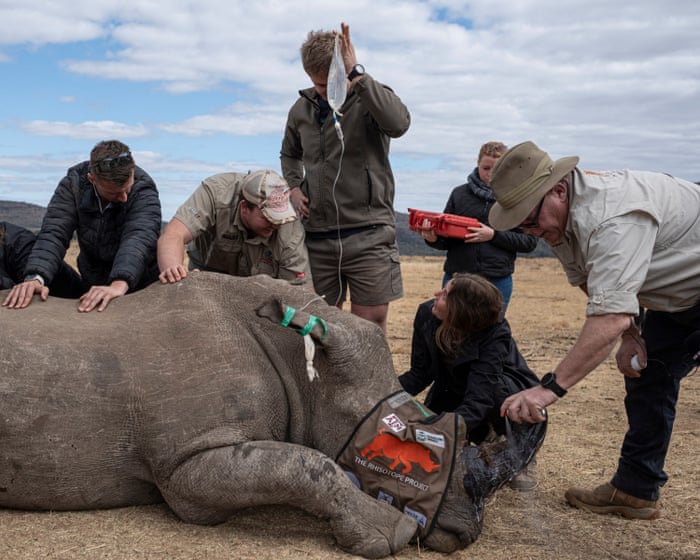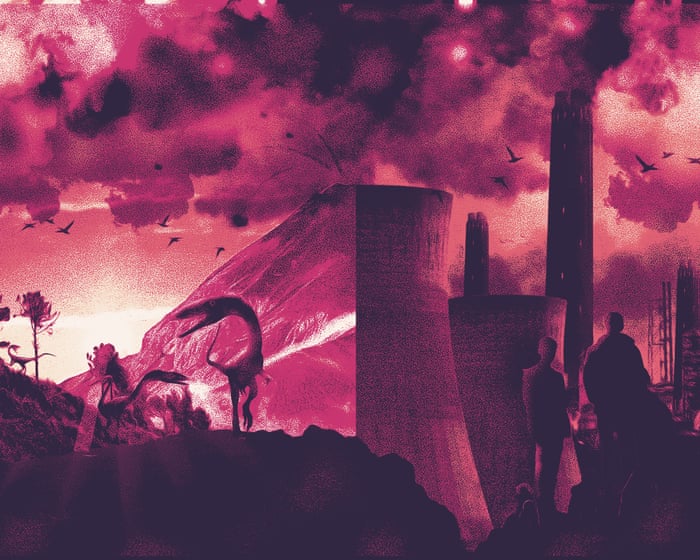On a cloudy Tuesday in July, divers Mitch Johnson and Sean Taylor pull on their wetsuits aboard the R/V Xenarcha, a 28-foot boat floating off the coast of Rancho Palos Verdes, south of Los Angeles. Behind them, the clear Pacific waters are filled with a forest of army-green kelp strands, swaying like mermaid hair beneath the surface.
We’re here to survey the giant Pacific kelp, a species that once flourished in these cold waters. But over the last twenty years, a mix of warmer ocean temperatures, pollution, overfishing, and the spread of hungry sea urchins that eat the kelp has caused an 80% decline in the forests along the Southern California coast.
In recent years, scientists have fought back—launching one of the world’s largest and most successful kelp restoration efforts. To do this, they’ve enlisted teams of divers armed with hammers to break apart and remove the ravenous urchins. Today’s trip offers a chance to witness that success firsthand.
From the edge of the boat, the kelp is so thick and strong in places that it forms mats on the ocean’s surface, sturdy enough for egrets and herons to perch on while hunting fish below. These waters are home to a wide range of species, from bright orange garibaldi fish and white sharks patrolling the coast to blue whales passing through the deep channel a few miles to the east.
Divers like Johnson and Taylor use various tools. Some days, they take rock hammers—like underwater versions of the seven dwarves—and dive down to crack open the purple urchins that destroy young kelp. But today, they’re equipped only with a tape measure and a camera to assess the condition of this vast hidden forest.
Once geared up, the divers give a thumbs-up to Tom Ford, CEO of the Bay Foundation, a nonprofit dedicated to restoring Santa Monica Bay and its coastal waters, who is steering the boat. With a small splash, they slip beneath the surface. Ford and I wait, listening to the gentle slap of waves against the Xenarcha, to see what they discover.
Led by the Bay Foundation, divers in Santa Monica Bay have spent over 15,575 hours underwater during the past 13 years. To revive the kelp, they focus on reducing the impact of one voracious eater: the purple urchin. The effort has paid off, with 5.8 million purple urchins removed and 80.7 acres (32.7 hectares, about 61 football fields) cleared, allowing the kelp to return.
But with these results hidden offshore and underwater, has anyone taken notice? Ford wonders the same. “We call it the forgotten forest,” he says.
Cathedrals in the Sea
These fast-growing kelp ecosystems are rightly called the “sequoias of the sea”: they store large amounts of carbon, provide habitat for more than 800 marine species, and help soften the impact of storm waves. Technically a type of macro-algae, kelp can grow up to two feet per day, reaching heights of 100 feet from the ocean floor to the surface.
For those lucky enough to see the kelp from below the waves, it feels like a fairytale—a forest where you fly instead of walk.
Ford still remembers his first scuba dive into the kelp forest. Sunlight filtered through the blades like flickering flames, and beams of light shone through gaps in the canopy. “It looked like a cathedral, with light streaming through stained glass,” he says. “Sometimes you drift down through it, and thousands of colorful fish are darting all around. It’s like flying through an unbelievably dense, living forest.”
But for a time, theThese beautiful underwater environments were in danger of vanishing. When the Bay Foundation began its work in these waters in 2012, the seafloor was covered in a carpet of purple—blanketed by golf ball-sized, spiky urchins native to the area.
This was a sign of an ecosystem in crisis, suffering from multiple overlapping problems. Sea otters, which rely on urchins as a key part of their diet, were nearly wiped out by hunters in the 1800s. Then, from the 1940s to the 1970s, a chemical plant discharged large amounts of DDT into the ocean near Palos Verdes. Landslides also buried the reefs in silt, making it impossible for anything to grow. More recently, local sea stars—another predator of urchins—were devastated by a wasting disease that turned them to mush. With no natural predators left, the urchin population exploded. They devour kelp at an alarming rate and scrape the reef so thoroughly that any remaining kelp spores couldn’t take hold.
Ford and the Bay Foundation conducted tests to determine the ideal number of urchins per square meter: just two. But in some areas, there were 70 to 80 urchins per meter. With little to eat, these were essentially “zombie urchins”—hungry, empty shells, barely surviving but still preventing kelp from growing. There was a lot of work ahead.
The foundation secured grants from state and federal agencies and began hiring divers, recruiting 75 volunteers, and even partnering with commercial fishers to help. Ford emphasizes that the team wasn’t harming the healthy urchins that support local livelihoods. “We paid fishermen to help restore the forest, so they could eventually return and fish there again,” he explains.
Terry Herzik, a longtime red sea urchin fisher, is a prime example. He started working with the foundation in 2012, spending nine hours a day smashing urchins instead of harvesting them for sale. “No one has spent more hours clearing urchins than Terry,” says Ford, pointing to Herzik’s boat, the Sun Spot, anchored nearby. “We couldn’t have done this without him.”
Slowly and methodically, divers went down week after week, clearing designated areas. Hitting an urchin with a foot-long rock hammer produces “a satisfying crunch,” says Johnson. He notes that it’s manual labor—just underwater, and while wearing bulky scuba gear.
The divers describe their work as being part of a construction crew—repetitive but rewarding, like filling potholes in the ocean. “You just tap, tap, and sometimes you have to reach into crevices to get the urchins out,” says Taylor. “Your forearms get really tired.”
The real payoff is seeing how quickly the kelp returns once the urchins are under control—sometimes in just a few months. That’s because microscopic kelp spores are always drifting in the water, much like seeds carried by the wind, waiting for the right conditions to attach to the reef and grow.
Johnson recalls one coastal area he worked on: “Within three months, the kelp came back. I’ve never seen a kelp forest that dense—it was amazing how fast it returned.”
Taylor and Johnson, both Bay Foundation employees, resurface and climb back onto the boat. Shaking seawater from their hair, they describe what they saw in the survey area: plenty of fish, a small shark, and a lush green forest.
“There’s still a lot of kelp,” Johnson tells Ford, but it’s not all good news. “There’s still a pocket where the urchins are spreading.” It remains a mystery why some areas stay restored with kelp while others revert to barren conditions.
The boat moves on to another location…At their spot along the coast, the divers descend once more. Here, the kelp forest is so dense it forms a mat that holds the boat in place.
“I’m not sure we even need to anchor,” Ford remarks. “I’ll just let the algae keep me steady.”
A close-up video shows kelp off the coast of Rancho Palos Verdes, California. Ford and I lift a frond from the water’s edge near the boat. It feels slippery, rubbery, and a little slimy. On its surface, I spot a colony of bryozoans—tiny filter-feeding invertebrates that live on the kelp. Small shrimp and snails also gather on the fronds, evidence of how vital this habitat is for so many creatures. I run my fingers along the blades, which are just beginning to differentiate and form the bulbs that keep the structure buoyant. Even as a parent to fast-growing kids, it’s hard to grasp how quickly this algae grows—always reaching upward and outward.
“Everything flows from the kelp,” Ford says.
The project could serve as a model for other regions where kelp is struggling. Restoration efforts are already underway in places like Tasmania and South Korea, and California’s Santa Barbara Channel is also a target for future work.
Despite the threat of warmer ocean temperatures in a changing climate, there are reasons for hope. Restored kelp forests have remained largely intact. Research from the foundation shows that California spiny lobsters have returned to the area, and fish like kelp bass and sheepshead are now more abundant than before restoration began. The kelp also improves water quality by absorbing excess nutrients and stabilizing sediment, much like trees prevent soil erosion after rain. These improvements have even benefited valuable red sea urchins—in restored areas, their gonads (the prized uni) weigh 168% more.
While the impact of urchins has been devastating, Ford notes that kelp has always faced challenges, from powerful waves tearing it from the seabed to summer temperatures that deplete the nutrients it needs to grow. This has made kelp incredibly resilient—ready to seize any opportunity to regrow. “Part of why we see such a rapid response to restoration is because the system has evolved to rebound quickly when conditions improve,” he explains.
Perhaps kelp will indeed have a fairytale future—one that supports the planet, people, and coastlines well into the next century.
Frequently Asked Questions
Of course Here is a list of FAQs about The forgotten forest and the urchin removal project designed to be clear and conversational
General Beginner Questions
Q What is The Forgotten Forest
A Its a nickname for the vast underwater kelp forests off the coast of Northern California that had nearly disappeared due to an overpopulation of sea urchins
Q Why were the kelp forests in trouble
A A disease wiped out the sunflower sea star which was the main predator of purple sea urchins Without predators the urchin population exploded and they ate all the kelp
Q Whats so important about kelp
A Kelp forests are like underwater rainforests They provide food and shelter for hundreds of species protect coastlines from erosion and absorb carbon dioxide
Q How do you rescue a kelp forest
A The main method used was to send divers down to carefully remove the overpopulated hungry sea urchins from the reef
Q Did they just kill all the urchins
A Not exactly The goal was to reduce their numbers to a sustainable level Many of the collected urchins were actually sold to seafood restaurants as their roe is a delicacy
Deeper Dive Advanced Questions
Q Why exactly 56 million urchins Was that a specific target
A It wasnt a preset target 56 million was the total number removed by the project divers over several years The goal was to clear enough urchins from key areas to give kelp spores a chance to regrow
Q What caused the sea star wasting disease that started this problem
A Scientists believe it was likely a virus that was exacerbated by warmerthanusual ocean waters making the sea stars more susceptible
Q Is the kelp forest fully recovered now
A Its a successful recovery in progress In the areas where urchins were removed the kelp has grown back dramatically and fish and other marine life have returned However its an ongoing effort to maintain
Q What are zombie urchins
A This is a term for urchins that have eaten




